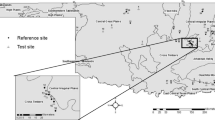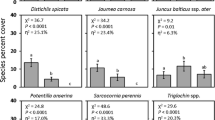Abstract
The complex task of determining the inundation requirements of large floodplain wetlands is often simplified through the use of representative, umbrella or flagship species. This subset of species is targeted based on the assumption that their collective inundation requirements serve as a surrogate for the broader suite of species found within the wetland. We tested the application of representative species commonly used in wetland and water management planning in the Murray-Darling Basin. In a review of the water requirements of 155 plants and animals, we collated information on preferred inundation timing, duration, depth, rate of rise and fall, and inter-flood period for 115 species. We then used cluster analysis to determine the extent to which ten commonly used representative species corresponded in inundation requirements to the broader suite of species. We found that the habitat surrogates of river red gum, black box, spike rush, coolibah, water couch, lignum and marsh club-rush represented only one third of species at a 60% level of similarity in inundation requirements, due mainly to the lower inundation return period and duration required by the habitat surrogates. The addition of faunal representative species facilitated the inclusion of a broader range of requirements, though primarily amongst related taxa. We recommend the inclusion of several additional indicator species to more adequately cover the inundation requirements of large wetland ecosystems.

Similar content being viewed by others
References
Bray JR, Curtis JT (1957) An ordination of the upland forest communities of southern Wisconsin. Ecological Monographs 27:325–349
Drosdowsky W (2005) The latitude of the subtropical ridge over Eastern Australia: The L index revisited. International Journal of Climatology 25:1291–1299
Frazier P, Page K (2006) The effect of river regulation on floodplain wetland inundation, Murrumbidgee River, Australia. Marine and Freshwater Research 57:133–141
Jones HA (2011) Crustaceans and molluscs. In: Rogers K, Ralph TJ (eds) Floodplain wetland biota in the Murray-Darling Baisn: water and habitat requirements. CSIRO Publishing, Collingwood, pp 275–310
Kingsford RT (2000a) Ecological impacts of dams, water diversions and river management on floodplain wetlands in Australia. Austral Ecology 25:109–127
Kingsford RT (2000b) Protecting rivers in arid regions or pumping them dry? Hydrobiologia 427:1–11
Kingsford RT, Thomas RF (2004) Destruction of wetlands and waterbird populations by dams and irrigation on the Murrumbidgee River in Arid Australia. Environmental Management 34:383–396
Kingsford RT, Brandis KJ, Jenkins KM, Nairn LC, Rayner TS (2010) Measuring ecosystem responses to flow across temporal and spatial scales. In: Saintilan N, Overton I (eds) Ecosystem response modelling in the Murray_darling Basin. CSORO Publishing, Collingwood, pp 15–36
Lytle DA, Poff NL (2004) Adaptation to natural flow regimes. Trends in Ecology and Evolution 19:94–100
MDBA (2011) Proposed basin Plan. MurrayDarling Basin Authority, Commonwealth of Australia
Murphy BF, Timbal B (2008) A review of recent climate variability and climate change in southeastern Australia. International Journal of Climatology 28:859–879
Nicholls N (2010) Local and remote causes of the southern Australian autumn-winter rainfall decline, 1958–2007. Climate dynamics
Poff NL, Allan JD, Bain MB, Karr JR, Prestegaard KL, Richter BD, Sparks RE, Stromberg JC (1997) The natural flow regime. BioScience 47:769–784
Puckridge JT, Sheldon F, Walker KF, Boulton AJ (1998) Flow variability and the ecology of large rivers. Marine and Freshwater Research 49:55–72
Ralph TJ, Hesse PP (2010) Downstream hydrogeomorphic changes along the Macquarie River, southeastern Australia, leading to channel breakdown and floodplain wetlands. Geomorphology 118:48–64
Richter BD, Baumgartner JV, Powell J, Braun DP (1996) A method for assessing hydrologic alteration within ecosystems Un Métro para Evaluar Alteraciones Hidrológicas dentro de Ecosistemas. Conservation Biology 10:1163–1174
Roberts J, Marston F (2011) Water regime for wetland and floodplain plants: a source book for the Murray–Darling Basin. National Water Commission, Canberra
Rogers K (2011) Waterbirds. In: Rogers K, Ralph TJ (eds) Floodplain wetland biota in the Murray-Darling Baisn: water and habitat requirements. CSIRO Publishing, Collingwood, pp 83–204
Rogers K, Ralph TJ (eds) (2011) Floodplain wetland biota in the Murray-Darling Basin: water and habitat requirements. CSIRO Publishing, Collingwood
Saintilan N (2011) Management of water for floodplain wetland biota. In: Rogers K, Ralph TJ (eds) Floodplain wetland biota in the Murray-Darlina Basin. CSIRO Publishing, Collingwood
Saintilan N, Ling J, Wen L (2009) The development of interdisciplinary flow-ecology models for the wetlands of the northern Murray-Darling Basin. In: Thoms M, Heal K, Bogh E, Chambel A, Smakhtin V (eds) Ecohydrology of Surface and Groundwater Dependent Systems: Concepts, Methods and Recent Developments. IAHS Publishing, Oxfordshire UK, pp 86–93
Simberloff D (1998) Flagships, umbrellas, and keystones: is single-species management passé in the landscape era? Biological Conservation 83:247–257
Thoms MC (2003) Floodplain-river ecosystems: lateral connections and the implications of human interference. Geomorphology 56:335–349
Tooth S, McCarthy TS (2007) Wetlands in drylands: geomorphological and sedimentological characteristics, with emphasis on examples from southern Africa. Progr Phys Geogr 31:3–41
Ummenhofer CC, England MH, McIntosh PC, Meyers G, Pook MJ, Risbey JS, Sen Gupta A, Taschettp AS (2009) What causes southeast Australia’s worst droughts?
Verdon DC, Franks SW (2006) Long-term behaviour of ENSO: interactions with the PDO over the past 400 years inferred from palaeoclimate records. Geophys Res Lett 33
Verdon DC, Wyatt AM, Kiem AS, Franks SW (2004) Multidecadal variability of rainfall and streamflow: Eastern Australia. Water Resources Research 40:1–8
Wassens S (2011) Frogs. In: Rogers K, Ralph TJ (eds) Floodplain wetland biota in the Murray-Darling Baisn: water and habitat requirements. CSIRO Publishing, Collingwood, pp 253–274
Wen L, Saintilan N, Ling J (2009) Wetland Ecological Character Description for Yanga National Park. Rivers and Wetlands Unit, NSW Department of Environment and Climate Change, Sydney, Australia
Winder M, Schindler DE (2004) Climate change uncouples trophic interactions in an aquatic ecosystem. Ecology 85:2100–2106
Young WJ, Scott AC, Cuddy SM, Rennie BA (2003) Murray flow assessment tool: A technical description. Commonwealth Scientific and Industrial Research Organisation Land and Water, Canberra, ACT, p 73.
Acknowledgements
The authors wish to acknowledge the contribution of Jennifer Spencer, Skye Wassens, Hugh Jones and Tom Rayner to the database of the water requirements of floodplain wetland biota in the Murray-Darling Basin. Funding for the database was provided by the NSW Office of Environment and Heritage, and the former NSW Greenhouse Office. We also acknowledge Paul Dajuk and Daniel O’Connor who developed the database framework; and Matt Colloff and an anonymous reviewer for providing valuable comments on this manuscript.
Author information
Authors and Affiliations
Corresponding author
Rights and permissions
About this article
Cite this article
Rogers, K., Ralph, T.J. & Saintilan, N. The Use of Representative Species as Surrogates for Wetland Inundation. Wetlands 32, 249–256 (2012). https://doi.org/10.1007/s13157-012-0285-9
Received:
Accepted:
Published:
Issue Date:
DOI: https://doi.org/10.1007/s13157-012-0285-9




